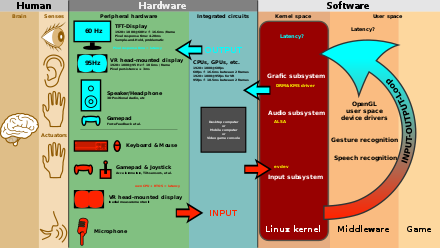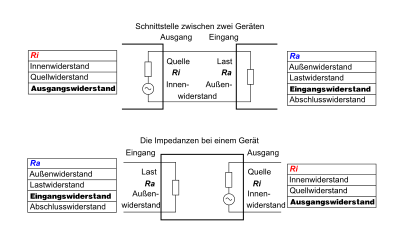interface

The interface (English Interface , [ ˈɪntəfeɪs ] or [ ˈɪnt̬ɚfeɪs ]) is the part of a system which is used for communication .
The term originally comes from natural science and describes the physical phase boundary between two states of a medium . He graphically describes the property of a system as a black box , of which only the "surface" is visible and therefore communication is only possible through it. Two neighboring black boxes can only communicate with each other if their surfaces “match”.
In addition, the word “intermediate layer” means: For the two boxes involved, it is irrelevant how the other internally handles the messages and how the responses to them come about. The description of the border is part of itself, and the black boxes only need to know the side facing them to ensure communication. This corresponds to the Latin word origin inter “between” and facies “appearance”, “form” for English face “face”.
If you look at any “ system ” as a whole that needs to be analyzed, you will “cut” this overall system into subsystems. The points that act as points of contact or starting points between these subsystems (via which communication takes place) then represent the interfaces. Using these interfaces, the subsystems can be reassembled into a larger whole. They then serve as seams .
Basics
Information is exchanged in the form of physical (e.g. electrical voltage , current strength ) or logical quantities ( data ) and can be analog (e.g. microphone on a sound input) or digital (e.g. parallel interface of the PC ) respectively. Not as interface are referred to general mechanical connecting elements of the design theory , which serve the communication of information (such as cables or springs).
One differentiates:
- Data interface - data as interfaces between programs
- Machine Interface - Interfaces between physical systems
- Hardware interface ( hardware interface ) - interfaces between physical systems of computer technology
- Network interface ( network interface ) - interfaces between network components
- Software interface ( software interface ) - interfaces between programs with each other , the operating system , to agree on methods in object-oriented programming , etc.
- User interface ( user interface ) - interfaces between man and machine
- "Common Interface" ( common interface ) for DVB reception appliances
An interface is described by a set of rules , the interface description . In addition to the description of which functions are available and how they are used, the interface description also includes a so-called contract that describes the semantics of the individual functions.
Standardized interfaces offer the advantage that components or modules that support the same interface can be exchanged for one another, i.e. they are compatible with one another .
It often happens that two participants in the communication must have different but matching interfaces (compatibility, e.g. plug - socket).
The term interface is also used in project management in plant construction, whereby interfaces describe the interactions between different trades to achieve the required functionality of a system.
Machine interface
Machine interface is the place at which a device or a machine interacts with another device or with another machine . Such an interface is described as follows.
Physical data
Mechanical parameters:
- local position (length, width, height, related to a reference point to be defined)
- Dimensions (length, width, height, possibly other dimensions of the mechanical interface, such as hole spacing or diameter for fastening)
- Connecting elements (type and position)
- Necessary forces and torques to ensure the static determination of the system (e.g. tightening torques for screws, riveted connections)
- Position of the force application points (e.g. foundation supports, scaffolding, beams)
- dynamic loads (e.g. vibrations, explosions)
- Pressures (max., Min. With hydraulics, pneumatics, possibly with conveyance)
- When conveying material (also air or liquids): type of material and amount per time unit (min., max.)
- Non-electrical forms of energy at the interface (pneumatics, hydraulics).
Electrical parameters:
- Location and type of electrical connection (s)
- electrical voltage (min., max.)
- electric current (min., max.)
- further, necessary information about line data (type and cross-section), grounding
- System parameters of electrical controls.
Thermal parameters:
- System temperatures (max., Min.)
Chemical source
- Required material properties of the construction materials of the original system and the systems to be connected
- If applicable, properties of the material to be conveyed
Hardware interfaces
Hardware interfaces are interfaces between physical systems in electrical engineering and electronics . The interface equipment of a device is often referred to as connectivity.
Hardware interfaces are widespread in computer technology. For example, industrial standards ensure that a PC is an open system that can be assembled from components from different manufacturers. Examples of hardware interfaces that are used in computers are the PCI bus , AGP , SCSI , USB , FireWire and the older EIA-232 (also known as RS-232 or V24).
A distinction is made between parallel and serial (hardware) interfaces, depending on whether several bits can be transmitted at the same time (see parallel data transmission ). In the context of peripheral devices for computers, the parallel interface generally means the IEEE 1284 connector, which is mostly used for the printer; In this context, the outdated EIA-232 interface is called serial interface.
In electrical engineering , every connection of analog or digital devices results in an interface when they come together. At each interface, the output resistance R a of the source and the input resistance R i of the load form an adaptation damping , which is also called interface damping . The important damping factor for this adaptation damping at the interface from the power amplifier to the loudspeaker must be observed in particular ; As with all connections in audio engineering, the latter is exclusively voltage matching with R i ≪ R a . Connecting a microphone to the input of a sound card provides an interface with the problems of matching attenuation, as does connecting a power amplifier to the loudspeaker. When connecting digital devices, R i = R a must be selected in order to avoid undesired and disruptive reflection of pulses . It is irrelevant that this condition coincidentally coincides with the one for performance adjustment.
See also
- Bluetooth
- Infrared Data Association or IrDA for short
- Wireless Local Area Network or WLAN, Wi-Fi or IEEE 802.11 for short
- adapter
- Interface attenuation , input impedance , output impedance , bit banging
- eBus
Software interfaces
Software interfaces or software-side data interfaces are logical points of contact in a software system: They enable and regulate the exchange of commands and data between different processes and components . Interfaces used in the software can basically be divided into:
- Only data-oriented interfaces used for communication: The interface always remains 'passive', it only contains the information that is exchanged between the system parts involved. Example: Address transfer with reference to the data / information to be used when calling subroutines .
- Interfaces as functional units: The interfaces used in this way carry out a specific functionality in order to synchronize or support the system parts primarily involved. Example: printer driver , see also programming interface .
Interfaces to interprocess communication
Some interfaces enable interprocess communication ( IPC ), communication between different programs on the same or another computer. Examples of such communication interfaces across a network are Remote Procedure Call , DCOM , RMI or CORBA (see also Interface Definition Language ), but also ODBC and JDBC . The well-known network protocols such as TCP , HTTP etc. can also be understood as IPC interfaces.
Interfaces for program components
Interfaces for program components are a formal declaration of which functions are available and how they can be addressed. This has the advantage that modules that have the same interface can be interchanged. It is also possible in this way to develop different components at the same time without the first having to be finished in order to translate the second. Such interfaces are used to modularize a software architecture .
An early example of such component interfaces are header files as used in C and C ++ . Interfaces are particularly important for program libraries that are only loaded during runtime ( dynamic libraries ): They allow you to recognize which program requires which library in which version. Depending on the intended use, important evaluation criteria of an interface are, for example, performance, scalability, transaction security or reliability.
Interfaces have a special meaning in object-oriented programming : Here they are used to define for certain classes which methods they must support and at which points instances of this class may be used. Ontologically , the affiliation of an instance to a certain interface means an is-a- relation.
See also
- Interface (UML)
- Common Business Object (CBO)
- Web service
- Digital interface for gas measuring devices
User interfaces
A user interface (or human-machine interface ) is the point at which a human interacts with a device . This can be switches and other control elements , displays of devices, but also the graphical user interface of a computer or a simple command line .
Organizational interfaces
Unifying facility
In addition to the technical interfaces, there are also interfaces in the area of organizational technology. Such interfaces are administrative or physical facilities that enable a smooth process within a company or among several companies and people. This in turn enables companies and people to exchange goods or communicate with one another in a simple and therefore inexpensive way.
Examples:
- Money as a standardized form of the exchange of values of goods and services between private individuals and companies in any combination.
- ISO container as a standardized form of transport packaging , thus a physical interface between logistics company, recipient and sender.
- Forms as a standardized form of information exchange, thus an interface between state and citizens.
- Department stores often offer structural interfaces to logistics companies in the form of pre-installed loading ramps that enable new goods to be loaded quickly.
Connection or separation point
In modern organizational theory, interfaces are connections or separation points between organizational units. Are z. B. formed from two cooperating organizations three, then the number of connection, interface or separation points increases from one to three. This makes sense if the content-related gain of the division of tasks between the organizations is greater than the effort required to operate the more frequent interfaces.
In parlance, the term “interface” is sometimes used for “interface”, especially to emphasize the connecting (versus separating) character of interfaces.
literature
- Wulf R. Halbach : Interfaces. Media and communication theoretical elements of an interface theory. Fink, Munich 1994, ISBN 3-7705-2934-0
Web links
- Interface technology in industrial production - an overview
- The interface between two audio devices and the adaptation

